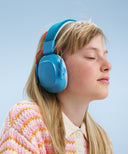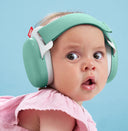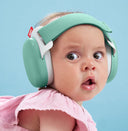The world around us is increasingly noisy, and children are constantly subjected to loud sounds. This puts babies and toddlers, whose ears are still developing, at an especially high risk of hearing damage. Parents may unwittingly expose their children to loud sounds that can lead to permanent hearing loss at an early age. We know that's something every parent wants to avoid, so in this article, we'll tell you about the link between loud noises and hearing loss in babies and children, the impact hearing impairment can have on them, and the decibel levels that can cause it. We'll also give you tips for preventing hearing damage in babies and children and selecting the right hearing protection.
What causes hearing damage in babies and children?
Some experts suggest that hearing damage can start in the womb (Dutch article). Audiologist Prof. Dr Bart Vinck (Ghent University) sees a significant number of babies with unilateral hearing damage. The abdominal wall and amniotic fluid are not enough to prevent all harmful frequencies from reaching the baby's ears, and Vinck believes that some cases of hearing damage are caused when mothers are exposed to high noise levels during pregnancy. However, the primary causes of hearing damage in babies and toddlers are actually their toys and the noises in their everyday environment.
Causes of hearing damage at home
Although you may not realise it, your home is often very noisy. Televisions, radios and other electronics, such as vacuum cleaners, food processors and hairdryers, can all generate a huge amount of noise at high decibel levels. But your children's own toys are also a potential risk. Children just love toys that make sounds, but if these are too loud, this can have serious consequences. Belgian research commissioned by a health insurance fund found that noisy toys can cause hearing damage in children. Within the European Union, the legal volume limit for toys for children under 14 is 90 dB. However, this is only safe when the toy is kept at least 25 centimetres away from the ears. Because young children are inclined to hold toys right up to their ears, playing with sound-making toys can quickly lead to permanent hearing damage.
The greatest risks for older children and teenagers are smartphones and earbuds. Listening to music through headphones or earbuds at a high volume, especially when this is done regularly, can cause irreversible hearing loss. Global studies reveal that 24% of children aged 12 and over listen to sound at unsafe levels. And the louder the sound, the more damage it can cause to hearing..
Causes of hearing damage outside the home
You have some control over the noise levels your children are exposed to at home, but that's often not possible outside the home. Crowds, honking horns, emergency sirens, rumbling lorries, blaring car alarms and noisy roadworks are some of the potential risks children are frequently exposed to. Music festivals are increasingly welcoming to families, but these also carry the risk of hearing damage. The risk is particularly high when children are perched on their parents' shoulders to get a better view. Their position above the crowd makes them even more exposed to the music's loud volume. And of course, we take our children along to other events where the noise can be ear-splittingly loud at times, such as Bonfire Night, fireworks displays, football matches and theatres and fun fairs.
The consequences of hearing damage in early childhood
Exposure to loud noises at a young age can have immediate consequences, such as:
- Difficulty hearing quiet or muffled sounds;
- Normal conversations sounding dull or unclear;
- Ringing or buzzing sound in the ears (tinnitus);
- Permanent hearing damage.
Frequent exposure to loud sounds can also cause symptoms that might not seem related to hearing damage, such as:
- Sleep problems;
- Tiredness;
- Difficulty concentrating;
- Irritability;
- Tummy aches or digestive problems;
- Elevated blood pressure;
Numerous well-researched papers and articles have been written about the impacts of loud noises on babies and young children.
We recommend Preventing Excessive Noise Exposure in Infants, Children, and Adolescents from the American Academy of Pedriatics, which discusses the impacts of excessive noise on infants and children.
Another interesting read is the World Report on Hearing, published by the World Health Organization (WHO) in 2021. This report outlines how hearing impairment can hinder the development of speech, language and cognitive skills, particularly in very young children, and how these delays can go on to impact their education, career prospects, mental health and social connections.
What noise levels are harmful to babies' and children's hearing?
Prolonged exposure to noise levels above 85 decibels can be harmful to adults. However, the safe volume threshold is much lower for babies, whose hearing is still developing. So what is a safe decibel level for babies? Audiologists advise against exposing infants to noises above 85 decibels, and 60 decibels – the volume of a normal conversation – is recommended as the safest upper limit. That's why it's essential to always be mindful of potentially harmful noises and to protect your child's ears whenever necessary.
Below are some everyday sounds, along with their volume levels and how quickly they can cause hearing damage:
|
Sound |
Average volume in dB |
Risk of hearing damage |
|
Whisper |
30 |
None |
|
Normal conversation |
60 |
None |
|
Passing car |
70 |
None |
|
Alarm clock, doorbell, vacuum cleaner |
80 |
After 8 hours |
|
Traffic noise |
83 |
After 4 hours |
|
Passing train, blender |
86 |
After 2 hours |
|
Shouting/cheering |
90 |
After 1 hour |
|
Drill |
95 |
After 15 minutes |
|
Club/live entertainment venue |
100 |
After 5 minutes |
|
Rock concert, chainsaw |
110 |
Immediate |
|
Sirens |
120 (pain threshold) |
Immediate |
|
Fireworks within 3 metres |
140+ |
Immediate |
Tips for preventing hearing damage in babies and children
#1. Be aware of noise levels in the home
Preventing hearing damage in children starts at home. Keep TV and music volume low, and remember that household appliances like hairdryers and blenders can be loud enough to cause hearing damage. It's best to minimise your child's exposure to them.
#2 Inspect toys that make noises
If your child's electronic toys make sounds, ensure they aren't too loud. If you suspect that they are too loud, you can remove the batteries or tape over the speaker, but be aware that you will still need to watch younger children closely when they play with the toys.
#3 Use volume limiters
Check the volume on the tablets and smartphones your child uses. You can limit the volume in the settings, which should keep the sound below 85 decibels. We strongly recommend using this feature.
#4 Give your child headphones
Provide your child with headphones specifically designed for children and encourage them to use them when they watch videos, play games and listen to music. Make sure they're a comfortable fit and provide effective sound insulation to block ambient noise so the volume can be kept at a lower level.
#5. Schedule 'ear breaks'
When your child is using headphones to listen to their devices, encourage them to take a break every 30 minutes. If they're watching videos, this will give their eyes a break as well as their ears! Establish clear rules about this and use a timer with an alarm to remind them.
#6. Teach children to keep a safe distance from speakers
Good habits start young, so teach your children to keep their distance from speakers from an early age. This should be at least 2 metres indoors and 10 metres outdoors. Even if they're not yet old enough to attend concerts and music festivals, they are likely to be exposed to loud music at sporting events, parties, performances and even at school.
#7. Invest in effective hearing protection
Buy good-quality hearing protection for your children and take it with you whenever they might be exposed to loud sounds. Later in this article, we'll tell you how to choose the right hearing protection for your child.
#8. Tell your child why hearing protection is important
Children are much more likely to wear hearing protection if they understand why it's important. Explain how loud sounds can harm their ears and how wearing ear defenders or earplugs help prevent hearing loss. Make wearing hearing protection routine, just like wearing a seatbelt in the car.
#9. Set a good example
Children learn through observation and imitation, so set a good example: Keep the volume of the TV and music low and use hearing protection when you do DIY or during other noisy activities. Encourage your child to do the same.
#10. Take care of their ears
Children's ear canals are still very small, which makes them prone to ear infections (otitis media). Five out of six children will have one or more ear infections by age three (source). To prevent ear infections, clean your child's ears regularly. Do not use cotton buds, as they can damage the eardrum. Instead, gently clean their ears with warm water and a washcloth.
#11. Be vigilant about your child's hearing
Parents and guardians should monitor their child's hearing and be alert to potential problems. A fun way to check your child's hearing is by playing listening games like 'I hear with my little ear'. Several simple hearing tests are also available online.
#12. Communicate concerns about your child's hearing
Your baby's hearing may be tested shortly after birth before you leave the hospital. Otherwise, a healthcare professional will check it within the first few weeks. You'll be asked about your child's hearing during their regular health assessments (up to age two and a half), so don't be afraid to mention any concerns you have, however small. Many children in the UK also have their hearing tested when they start school to check for potential problems.
If you're worried about your child's hearing at any point, ask your doctor or health visitor about having it checked.
#13. Take ear complaints seriously
If your child complains of ringing or buzzing in their ears, it could be a sign of potential hearing problems. Consult your GP if these symptoms last more than a day or two, especially if this is a recurring issue.
When does my baby need hearing protection?
Although it's best to avoid exposing your baby to loud noises, it's not always possible to do so. Effective hearing protection is an effective solution in a variety of circumstances where your child could be exposed to high decibel levels.
- At parties and events
Social occasions and events, like weddings, festivals, parades, parties, fun fairs, football matches and other sporting events all generate noise at significant volumes. And as mentioned earlier, fireworks can be particularly harmful to children's hearing. Even if you keep your child at a safe distance from the fireworks, it's still best to protect their ears from the loud bangs.
- While travelling
We strongly recommend using ear protection for babies while travelling. As well as being sensitive to noise, babies can be overwhelmed by visual stimuli, and a busy plane or train can quickly become distressing for them. Hearing protection not only protects babies from loud noises but also helps prevent overstimulation. An added benefit is that babies often fall asleep more easily when they're wearing hearing protection, making the journey less stressful for you, too!
- At home
There may be times when it's a good idea to use hearing protection for your baby at home. For example, if their older siblings are playing loud music, or if you're doing noisy jobs around the house or in the garden, like drilling, sanding or mowing the lawn. Don't forget to wear your own hearing protection while you're working!
How do I choose the best hearing protection for babies and children?
Alpine offers a complete range of high-performance hearing protection for babies and children. But how do you know which product is best for your child? It's important to make sure the product is appropriate for their age and the specific situation or activity.
Hearing protection for babies
The Alpine Muffy Baby Classic is designed to prevent hearing damage and sensory overload in babies and toddlers up to 36 months. These safe, CE-certified ear defenders use multiple layers of attenuating foam to protect your baby's ears from hearing damage, reducing noise levels by up to 23 dB.
For extra comfort and noise reduction, we recommend the new Alpine Muffy Baby earmuffs. These comfortable, extra-soft earmuffs reduce noise by up to 24 dB and are suitable for children aged up to 48 months. An added benefit of the Alpine Muffy Baby earmuffs is that they contain no metal parts, so they're safe for use during MRI scans as well.
Alpine Muffy Baby Classic and the new Alpine Muffy Baby are suitable for babies aged 12 months and up.
Hearing protection for children
We know you'll want to protect your children's hearing throughout their development, not just when they're babies. That's why Alpine also offers ear defenders for children ages 5 and up: the Alpine Muffy Kids. For children aged 3 to 12, Alpine Pluggies Kids are a great option. These specially designed children's earplugs protect their hearing from harmful noise levels, but they will also prevent water from entering their ears while swimming, showering or doing water sports.



